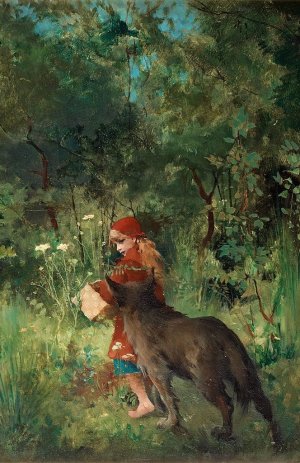| Library / Literary Works |
Biography of Charles Perrault

Portrait (detail) by Philippe Lallemand, 1672.Charles Perrault (12 January 1628 – 16 May 1703) was a French author who laid foundations for a new literary genre, the fairy tale, and whose best known tales, often derived from pre-existing folk tales, include Le Petit Chaperon rouge (Little Red Riding Hood), La Belle au bois dormant (Sleeping Beauty), Le Maître chat ou le Chat botté (Puss in Boots), Cendrillon ou la petite pantoufle de verre (Cinderella), La Barbe bleue (Bluebeard), Le Petit Poucet (Hop o' My Thumb), Les Fées (Diamonds and Toads), La Marquise de Salusses ou la Patience de Griselidis (Patient Griselda), Les Souhaits ridicules (The Ridiculous Wishes), Peau d'Âne (Donkeyskin) and Riquet à la houppe (Ricky of the Tuft).
Perrault's most famous stories are still in print today and have been made into operas, ballets (e.g., Tchaikovsky's Sleeping Beauty), plays, musicals, and films, both live-action and animation.
Perrault was born in Paris to a wealthy bourgeois family, son of Pierre Perrault and Paquette Le Clerc. His brother, Claude Perrault, is remembered as the architect of the severe east range of the Louvre, built between 1665 and 1680.
Charles attended the best schools and studied law before embarking on a career in government service. He took part in the creation of the Academy of Sciences as well as the restoration of the Academy of Painting. When the Academy of Inscriptions and Belles-Lettres was founded in 1663, Perrault was appointed its secretary and served under Jean Baptiste Colbert, finance minister to King Louis XIV. He married Marie Guichon, age 19, in 1672, who died in 1678 after giving birth to a daughter. The couple also had three sons.
He was a major participant in the French Quarrel of the Ancients and the Moderns (Querelle des Anciens et des Modernes), which pitted supporters of the literature of Antiquity (the "Ancients") against supporters of the literature from the century of Louis XIV (the "Moderns"). He was on the side of the Moderns and wrote Le Siècle de Louis le Grand (The Century of Louis the Great, 1687) and Parallèle des Anciens et des Modernes (Parallel between Ancients and Moderns, 1688–1692) where he attempted to prove the superiority of the literature of his century.
In 1695, when he was 67, he lost his post as secretary. He decided to dedicate himself to his children and published Tales and Stories of the Past with Morals (Histoires ou Contes du Temps passé) (1697), with the subtitle: Tales of Mother Goose (Les Contes de ma Mère l'Oie).
Its publication made him suddenly widely-known beyond his own circles and marked the beginnings of a new literary genre, the fairy tale. He had actually published it under the name of his last son (born in 1678), Pierre (Perrault) Darmancourt, (Armancourt was the name of a property he bought for him), probably fearful of criticism from the "Ancients".
In the tales, he used images from around him, such as the Chateau Ussé for Sleeping Beauty and in Puss-in-Boots, the Marquis of the Château d'Oiron, and contrasted his folktale subject matter, with details and asides and subtext drawn from the world of fashion. He died in Paris in 1703 at age 75.
